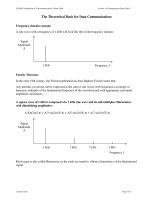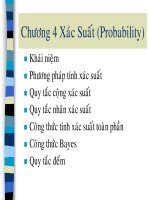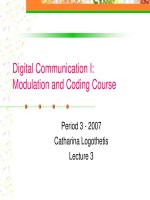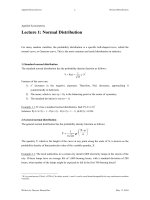Lecture 4_Set_Map_Hash.pptx
Bạn đang xem bản rút gọn của tài liệu. Xem và tải ngay bản đầy đủ của tài liệu tại đây (658.63 KB, 29 trang )
Set, Map and Hash
table
University of Technology and Engineering
Vietnam National University, Hanoi
Set
➢ A set is a
collection of
elements which
are not in any
particular order
➢ All elements of a
set are different
2
Set operations
3
Set operations Union
➢ Definition: Let A and B be sets, the
union of two sets A and B is the set that
contains all elements in A, B, or both.
➢ Example:
A={0,1,3, 5,8}
0
B= {2,5,8,9}
A∪B = {0,1,2,3,5,8,9}
Note: A∪B = B∪A
1
8
5
2
9
3
4
Set operations
Intersection
➢ Definition: Let A and B be sets, the
intersection of two sets A and B is the
set of elements that are in both A and B.
2
➢ Example:
A={1,2, 3,4,5}
B= {1,3,9,12}
A ∩B = {1,3}
Note: A∩B = B∩A
1
3
4
9
12
5
5
Set operations Minus
➢ Definition: Let A and B be sets, the
difference of A minus B (A – B) is the set
of elements that are in A, but not in B.
➢ Example:
A={1,2,3}
B= {2,3,4}
A - B = {1}
1
2
3
4
6
Using set library
Unordered sets are containers that store unique
elements in no particular order
// unordered_set::insert
#include <iostream>
#include <string>
#include <array>
#include <unordered_set>
int main () {
std::unordered_set<std::string> myset = {"yellow","green","blue"};
std::array<std::string,2> myarray = {"black","white"};
std::string mystring = "red";
myset.insert (mystring); // copy insertion
myset.insert (myarray.begin(), myarray.end()); // range insertion
myset.insert ( {"purple","orange"} ); // initializer list insertion
std::cout << "myset contains:";
for (const std::string& x: myset) std::cout << " " << x;
std::cout << std::endl;
}
return 0;
Example: Insert elements to a set
7
Maps
➢ A map models a searchable collection of keyvalue entries
➢ Multiple entries with the same key are not
allowed
Key
Value
0000001
Le Sy Vinh
0000002
Nguyen Van An
0000003
Tran Quoc Hung
8
The map operations
➢ get(k): if the map M has an entry with key k,
return its associated value; else, return null
➢ put(k, v): insert entry (k, v) into the map M; if
key k is not already in M, then return null; else,
return old value associated with k
➢ remove(k): if the map M has an entry with key
k, remove it from M and return its associated
value; else, return null
9
Example
Operation
Output
Map
put(5,A)
null
(5,A)
put(7,B)
null
(5,A),(7,B)
put(2,C)
null
(5,A),(7,B),(2,C)
put(8,D)
null
(5,A),(7,B),(2,C),(8,D)
put(2,E)
C
(5,A),(7,B),(2,E),(8,D)
get(7)
B
(5,A),(7,B),(2,E),(8,D)
get(4)
null
(5,A),(7,B),(2,E),(8,D)
get(2)
E
(5,A),(7,B),(2,E),(8,D)
remove(5) A
(7,B),(2,E),(8,D)
remove(2) E
(7,B),(8,D)
get(2)
null
(7,B),(8,D)
10
A Simple List-Based Map
We can easily implement a map using a
singly linked list
head
9 c
6 c
5 c
8 c
entries
11
The get(k) Algorithm
Algorithm get(k):
p = head;
while p is not null do
if p→element.key = k then
return p→element.value;
p = p→next;
return null {there is no entry with key equal to
k};
Complexity?
12
The put(k,v) Algorithm
Algorithm put(k,v):
p = head;
while p is not null do
if p.element.key = k then
t = p→element.value;
p→element.value = v;
return t {return the old value};
p = p→next;
insertLast((k,v));
return null {there was no previous entry with key
equal to k};
Complexity?
13
The remove(k) Algorithm
Algorithm remove(k):
p = head;
while p is not null do
if p.element.key = k then
t = p→element.value;
remove (p);
return t {return the old value};
p = p→next;
return null {there is no entry with key equal to
k};
Complexity?
14
Performance of a List-Based
Map
➢ get(k): O(n)
➢ put(k, v): O(n)
➢ remove(k): O(n)
Need a data structure to implement map
efficiently
15
Using map library
#include <iostream>
#include <string>
#include <map>
int main (){
std::map<char,int> mymap;
mymap['a']=10;
mymap['b']=20;
mymap['c']=30;
mymap.at('a') = 15;
mymap.at('b') = 50;
std::map<char,int>::iterator it;
for (it=mymap.begin(); it!=mymap.end(); ++it)
std::cout << it->first << ": " << it->second << '\n';
return 0;
}
16
Simple map
How to implement a simple map whose keys are
integer numbers in range 0…1000?
Key
0
1
2
500
1000
Value
A
B
B
G
F
0
1
2
500
1000
A
B
B
G
F
Using an array of 1001 elements to store a map
17
Complexity of simple map
operations
➢ get(k):
return M[k];
Complexity: O(1)
➢ put(k, v):
old_value = M[k];
M[k] = v;
return old_value;
Complexity: O(1)
➢ remove(k):
M[k] = Null;
Complexity: O(1)
18
Hash Tables
Hash Functions
A hash function h maps keys of a given type to integers in a
fixed interval [0, N − 1]. The integer h(x) is called the hash
value of key x
Example: h(x) = x mod N
x
0
3
1001
1002
1005
h(x)
0
3
1
2
5
Value
A
B
B
G
F
h(x) = x mod 1000
20









